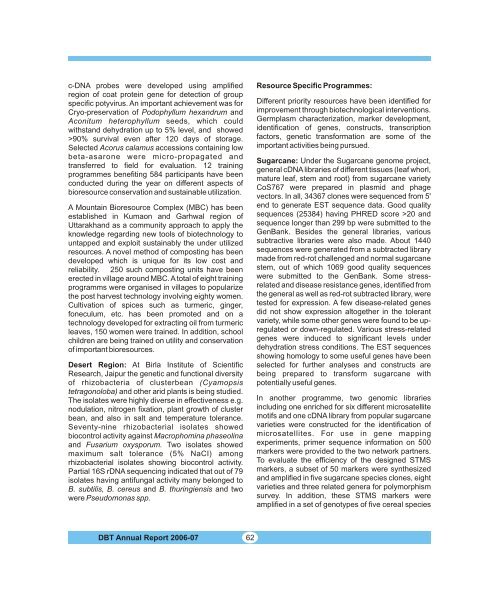ANNUAL REPORT - Department of Biotechnology
ANNUAL REPORT - Department of Biotechnology
ANNUAL REPORT - Department of Biotechnology
Create successful ePaper yourself
Turn your PDF publications into a flip-book with our unique Google optimized e-Paper software.
c-DNA probes were developed using amplified<br />
region <strong>of</strong> coat protein gene for detection <strong>of</strong> group<br />
specific potyvirus. An important achievement was for<br />
Cryo-preservation <strong>of</strong> Podophyllum hexandrum and<br />
Aconitum heterophyllum seeds, which could<br />
withstand dehydration up to 5% level, and showed<br />
>90% survival even after 120 days <strong>of</strong> storage.<br />
Selected Acorus calamus accessions containing low<br />
beta-asarone were micro-propagated and<br />
transferred to field for evaluation. 12 training<br />
programmes benefiting 584 participants have been<br />
conducted during the year on different aspects <strong>of</strong><br />
bioresource conservation and sustainable utilization.<br />
A Mountain Bioresource Complex (MBC) has been<br />
established in Kumaon and Garhwal region <strong>of</strong><br />
Uttarakhand as a community approach to apply the<br />
knowledge regarding new tools <strong>of</strong> biotechnology to<br />
untapped and exploit sustainably the under utilized<br />
resources. A novel method <strong>of</strong> composting has been<br />
developed which is unique for its low cost and<br />
reliability. 250 such composting units have been<br />
erected in village around MBC. A total <strong>of</strong> eight training<br />
programms were organised in villages to popularize<br />
the post harvest technology involving eighty women.<br />
Cultivation <strong>of</strong> spices such as turmeric, ginger,<br />
foneculum, etc. has been promoted and on a<br />
technology developed for extracting oil from turmeric<br />
leaves, 150 women were trained. In addition, school<br />
children are being trained on utility and conservation<br />
<strong>of</strong> important bioresources.<br />
Desert Region: At Birla Institute <strong>of</strong> Scientific<br />
Research, Jaipur the genetic and functional diversity<br />
<strong>of</strong> rhizobacteria <strong>of</strong> clusterbean (Cyamopsis<br />
tetragonoloba) and other arid plants is being studied.<br />
The isolates were highly diverse in effectiveness e.g.<br />
nodulation, nitrogen fixation, plant growth <strong>of</strong> cluster<br />
bean, and also in salt and temperature tolerance.<br />
Seventy-nine rhizobacterial isolates showed<br />
biocontrol activity against Macrophomina phaseolina<br />
and Fusarium oxysporum. Two isolates showed<br />
maximum salt tolerance (5% NaCI) among<br />
rhizobacterial isolates showing biocontrol activity.<br />
Partial 16S rDNA sequencing indicated that out <strong>of</strong> 79<br />
isolates having antifungal activity many belonged to<br />
B. subtilis, B. cereus and B. thuringiensis and two<br />
were Pseudomonas spp.<br />
DBT Annual Report 2006-07<br />
62<br />
Resource Specific Programmes:<br />
Different priority resources have been identified for<br />
improvement through biotechnological interventions.<br />
Germplasm characterization, marker development,<br />
identification <strong>of</strong> genes, constructs, transcription<br />
factors, genetic transformation are some <strong>of</strong> the<br />
important activities being pursued.<br />
Sugarcane: Under the Sugarcane genome project,<br />
general cDNA libraries <strong>of</strong> different tissues (leaf whorl,<br />
mature leaf, stem and root) from sugarcane variety<br />
CoS767 were prepared in plasmid and phage<br />
vectors. In all, 34367 clones were sequenced from 5'<br />
end to generate EST sequence data. Good quality<br />
sequences (25384) having PHRED score >20 and<br />
sequence longer than 299 bp were submitted to the<br />
GenBank. Besides the general libraries, various<br />
subtractive libraries were also made. About 1440<br />
sequences were generated from a subtracted library<br />
made from red-rot challenged and normal sugarcane<br />
stem, out <strong>of</strong> which 1069 good quality sequences<br />
were submitted to the GenBank. Some stressrelated<br />
and disease resistance genes, identified from<br />
the general as well as red-rot subtracted library, were<br />
tested for expression. A few disease-related genes<br />
did not show expression altogether in the tolerant<br />
variety, while some other genes were found to be upregulated<br />
or down-regulated. Various stress-related<br />
genes were induced to significant levels under<br />
dehydration stress conditions. The EST sequences<br />
showing homology to some useful genes have been<br />
selected for further analyses and constructs are<br />
being prepared to transform sugarcane with<br />
potentially useful genes.<br />
In another programme, two genomic libraries<br />
including one enriched for six different microsatellite<br />
motifs and one cDNA library from popular sugarcane<br />
varieties were constructed for the identification <strong>of</strong><br />
microsatellites. For use in gene mapping<br />
experiments, primer sequence information on 500<br />
markers were provided to the two network partners.<br />
To evaluate the efficiency <strong>of</strong> the designed STMS<br />
markers, a subset <strong>of</strong> 50 markers were synthesized<br />
and amplified in five sugarcane species clones, eight<br />
varieties and three related genera for polymorphism<br />
survey. In addition, these STMS markers were<br />
amplified in a set <strong>of</strong> genotypes <strong>of</strong> five cereal species

















